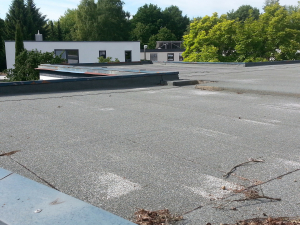Why are Flat Roofs Common on Commercial Buildings?
When people think about roofs, the most common image that comes into mind is that of a peaked roof. If you ask a kid, or even an adult, to draw a picture of a house, they will most likely draw a box with a triangle on top. However, if you actually go outside and observe the roofs around your area, especially when you are in the city, you’ll likely see that most roofs don’t actually form a peak. Instead, the majority of roofs are flat, especially on commercial buildings.
Why do commercial property owners have mostly flat roofs while residential owners prefer having sloped roofs?

One of the reasons behind this is that flat roofing is not only just as effective as sloped roofing, but is even more cost-effective, and tends to fit into the uniform ideal that most business and industrial districts demand.
Flat or also known as low-slope roofing is the type of roofing with 3-12 degrees of slope relative to the walls. This type of roofing was originally popular for desert-based civilizations and castles. However, flat roofing has become a common roofing choice in business districts and high rise downtowns of the world. One of the reasons behind this is the development of improved, better, and more cost-effective roofing materials that could be mass produced to a high standard.
Roofing Materials
Thermoplastic Polyolefin or TPO is a durable and synthetic material with properties similar to EPDM which is another kind of synthetic rubber. Having this type of synthetic roof provides added heat resistance from its employment of a vinyl composite in its makeup. One of the benefits of TPO is that it provides a higher level of UV protection and provides structural integrity that makes it capable of supporting heavy equipment making it a good choice for a commercial or industrial building.
Polyvinyl Chloride is often used in piping networks, some decking, and even some furniture. Aside from those uses, the material is also used to create a sturdy roofing membrane. PVC roofing is actually very strong and durable that it is capable of handling loads weighing more than 350 pounds per square inch.
EPDM is another synthetic rubber material which offers the lowest cost per square foot of any flat-roofing material. This lower cost does not mean that EPDM does not have any merits. EPDM is capable of roofing and insulating a commercial building for more than 3 decades.
Asphalt is a material which is typically used in the construction of roads and bridges. Additionally, asphalt has long been used in roofing. Many manufacturers now produce asphalt roofing materials for roofing membranes for flat-roofed buildings. These asphalt roofing membranes are sturdy, durable, tough and rugged. Many roofing contractors consider this material to be one of the best with a life span of over 50 years.
Metal is another material which is very commonly used for flat roofing. Many flat roof warehouses have a flat metal roof. The main reasons why metal is such a popular option is because metal is a practical, long-lasting, and efficient material. Metal roofs on can last for more than 30 years. This is why it is a go to choice for most property owners.
Why Choose A Flat Roof?
The main reasons why commercial properties often have flat roofs are because this style of roofing is economic and efficient, adds curb appeal, optimizes space, and are long lasting and durable.
Economic and Efficient
While flat roofs can seem a bit pricey at first, the lifespan of the materials and the low maintenance costs over time actually make it a more cost effective option, especially for business owners with larger properties.
Adds Curb Appeal
There are many different materials which can be used for a flat roof. Many of the synthetic options provide a variety of colors available. However, even when you choose a simple material with less aesthetic appeal, flat roofs are not visible from the ground floor.
Space Optimization
One of the most common reasons for the popularity of flat roofs is that it provides commercial buildings with an extra space to use for a number of purposes. Property owners can install swimming pools, sky gardens, or place industrial machines on their flat roofs. This extra space is commonly used for HVAC and building ventilation systems.
Durable And Long Lasting
Last but definitely not the least is the longevity and durability that most flat roofing materials provide. If you’re looking to get a new roof for your commercial property, flat roofs aren’t just a common choice, they are a durable, long lasting, and cost effective option which provides a myriad of benefits.

